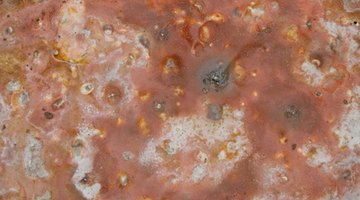Types of Worms in a Septic Tank
A septic tank is an integral component of a sewage treating septic system. It can be thought of as a small-scale waste treatment plant, common to areas where access to sewage pipes is not provided. It is estimated that approximately 25 percent of the North American population relies on septic tanks to dispose of waste.

Anaerobic bacteria decompose most septic waste matter. Non-decomposed waste is removed physically or chemically treated. Septic tanks often harbor disease causing parasitic worms and leaks are known to contaminate drinking water.
Cryptosporidium Parvum
Cryptosporidium parvum is a parasitic worm that causes cryptosporidiosis (or crypto), a disease of the intestinal track. Cryptosporidiosis is caused by ingesting cryptosporidium oocysts, which are borne and thrive in water contaminated with fecal waste. Wastewater from the tank seeps into river catchments used for drinking, contaminating it with the parasite. The parasite multiplies in the intestinal chamber of mammals, causing dehydration, weight loss, stomach cramps, nausea, vomiting and fever. Cryptosporidium parvum is often found in septic tanks. According to a serological research conducted by the FDA, approximately 80 percent of the North American population has had cryptosporidiosis one point or the other in their lives. The main culprit is believed to have been contaminated septic tank water.
Tapeworms
Tapeworms, or cestoda, are parasitic worms that live in the intestinal track and other body parts of mammals. Tapeworms are broadly classified into two types, namely intestinal tapeworms and tissue tapeworms. Intestinal tapeworms complete their lifecycle in the intestine, absorbing nutrients from the the digestive track of their host. Types of intestinal tapeworms include beef tapeworm (Taenia saginata), rat/dwarf tapeworm (Hymenolepis diminuta and Hymenolepis nana), dog tapeworm (Dipylidium caninum) and fish tapeworm (Diphyllobothrium latum). Tissue tapeworms contaminate the human body with eggs, or cysts, and include pork tapeworm (Taenia solium) and Hydatid Tapeworm (Echinococcus granulosus). A tapeworm infection causes diarrhea, abdominal pain, fatigue and nausea and is treated by prescribed anthelmintic drugs.
Roundworms
Roundworms, or nematodes, are parasitic worms that live in the human intestinal track. The symptoms of a roundworm infection include diarrhea, nausea, abdominal pain, weight loss, fatigue, shortness of breath and cough. There are various types of roundworms, including pinworm, hookworm (necator and ancylostoma), whipworm, ascaris lumbricoides, strongyloidiasis stercoralis, trichinosis spiralis, strongyloidiasis, and trichinosis. Diseases caused by roundworms include trichinosis, strongyloidiasis, trichuriasis, ancylostomiasis and ascariasis.
The Drip Cap
- A septic tank is an integral component of a sewage treating septic system.
- It is estimated that approximately 25 percent of the North American population relies on septic tanks to dispose of waste.
- Cryptosporidiosis is caused by ingesting cryptosporidium oocysts, which are borne and thrive in water contaminated with fecal waste.
- Tissue tapeworms contaminate the human body with eggs, or cysts, and include pork tapeworm (Taenia solium) and Hydatid Tapeworm (Echinococcus granulosus).
- The symptoms of a roundworm infection include diarrhea, nausea, abdominal pain, weight loss, fatigue, shortness of breath and cough.
References
Writer Bio
Natasha Gilani has been a writer since 2004, with work appearing in various online publications. She is also a member of the Canadian Writers Association. Gilani holds a Master of Business Administration in finance and an honors Bachelor of Science in information technology from the University of Peshawar, Pakistan.
Photo Credits
- septic image by Trevor Allen from Fotolia.com
- septic image by Trevor Allen from Fotolia.com
More Articles



